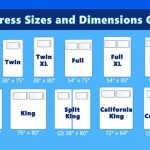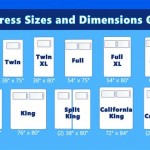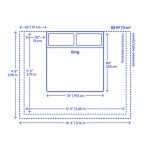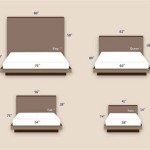The Enduring Appeal of the King-Size Bed
The king-size bed represents a significant upgrade in sleep comfort and bedroom aesthetics for many individuals and couples. Offering substantially more space than smaller mattress sizes, it caters to a diverse range of needs and preferences, from those seeking ample room to stretch out during the night to those prioritizing undisturbed sleep while sharing the bed. This article will explore the key characteristics of the king-size bed, its advantages, considerations for purchase, and how it compares to other common bed sizes, particularly the queen-size, to provide a comprehensive understanding of its appeal.
Dimensions and Space Considerations
The standard dimensions of a king-size mattress are 76 inches wide and 80 inches long. This generous surface area translates to 38 inches of personal space per person when shared by two individuals, which is equivalent to the width of a twin-size bed per person. This increased personal space is a primary driver for couples upgrading from a queen-size bed, which offers considerably less individual room. The overall footprint of a king-size bed requires careful consideration of bedroom dimensions. A room measuring at least 12 feet by 12 feet is generally recommended to comfortably accommodate the bed and allow for adequate walking space and furniture placement. Smaller rooms may feel cramped, negating the advantages of the larger mattress.
Beyond the standard king size, variations exist to cater to specific needs. The California king, for instance, is 72 inches wide and 84 inches long, sacrificing some width for extra length. This is a popular choice for taller individuals who require additional legroom. However, it's crucial to note that California king bedding is less readily available than standard king bedding, potentially limiting design options. Another variation, the split king, consists of two twin XL mattresses placed side-by-side. This configuration addresses motion transfer concerns, allowing each sleeper to adjust their side of the bed independently, particularly beneficial with adjustable bed frames.
When evaluating the suitability of a king-size bed, it's essential to measure the bedroom dimensions accurately, taking into account existing furniture and desired furniture placement. Consider door swing paths, window placements, and the proximity of electrical outlets. A scaled floor plan can be helpful in visualizing the bed's placement and ensuring ample space for movement and functionality. Beyond the mattress itself, the bed frame adds to the overall dimensions, so factor in the frame's width and length when calculating the total space required.
Benefits of a King-Size Bed
The primary benefit of a king-size bed is enhanced sleep comfort. The increased personal space allows for freedom of movement and reduces the likelihood of disturbing a sleeping partner. This is particularly significant for restless sleepers who tend to toss and turn throughout the night. The ample surface area also provides a more comfortable sleeping environment for individuals with different sleep positions. Whether one prefers to sleep on their back, side, or stomach, a king-size bed offers the space to accommodate these preferences without feeling confined.
Improved sleep quality translates to numerous downstream benefits, including increased energy levels, improved mood, enhanced cognitive function, and reduced stress. Chronic sleep deprivation can have detrimental effects on physical and mental health, so investing in a sleep environment that promotes restful sleep is a worthwhile endeavor. A king-size bed can be a significant contributor to achieving this goal.
Another benefit, often overlooked, is the aesthetic appeal of a king-size bed. It can serve as a focal point in the bedroom, creating a sense of luxury and spaciousness. The larger size allows for more elaborate bedding and decorative pillows, enhancing the overall visual appeal of the room. Furthermore, a king-size bed can create a sense of balance and proportion in larger bedrooms, preventing the space from feeling empty or unfinished.
For families with young children or pets, a king-size bed can also provide a comfortable space for occasional snuggling or story time. While it's not intended to be a permanent sleeping arrangement for additional individuals, the extra space allows for temporary accommodation without compromising the primary sleepers' comfort.
Considerations Before Purchasing
Despite the numerous benefits, there are several factors to consider before purchasing a king-size bed. The most significant is the cost. King-size mattresses, frames, and bedding are generally more expensive than their smaller counterparts. The increased material required for manufacturing and the specialized nature of king-size bedding contribute to the higher price point. Therefore, it's essential to factor in the overall cost, including the mattress, frame, bedding, and potentially, new bedroom furniture to complement the larger bed.
Another consideration is the logistical challenge of moving a king-size bed. The sheer size and weight of the mattress and frame can make transportation and maneuvering difficult, especially in tight spaces. Professional movers may be required to ensure damage-free delivery and setup. When selecting a mattress, consider its construction and weight. Some mattresses, such as those with inner springs, can be particularly heavy and cumbersome to move. Foam mattresses, while often lighter, can be more difficult to maneuver in narrow hallways or stairwells.
Storage can also be a challenge with a king-size bed. Finding adequate storage space for king-size bedding, such as sheets, comforters, and blankets, requires careful planning. Consider purchasing storage containers specifically designed for bedding, or utilizing under-bed storage solutions to maximize available space. Regularly decluttering and rotating bedding can also help to manage storage needs.
Compatibility with existing bedroom furniture is another important factor. A king-size bed may require upgrading nightstands, dressers, and other furniture to maintain a sense of proportion and balance in the room. The existing furniture may appear too small or out of scale when placed alongside a king-size bed, impacting the overall aesthetic appeal of the bedroom. Consider the style and finish of the existing furniture when selecting a bed frame and bedding to ensure a cohesive and harmonious look.
Finally, and often overlooked, is the consideration of the sleeper's individual needs. While a king-size bed provides ample space, it may not be the ideal solution for everyone. Individuals who consistently sleep alone or those with limited bedroom space may find a queen-size bed more practical and cost-effective. The benefits of a king-size bed are most pronounced when shared by two individuals or when personal space is a primary concern. Evaluating individual sleep habits and preferences is crucial in determining the best mattress size.
King-Size vs. Queen-Size: A Comparative Analysis
The queen-size bed is a popular and versatile option that strikes a balance between space and affordability. Measuring 60 inches wide and 80 inches long, it provides sufficient sleeping space for couples and individuals alike. However, when compared to a king-size bed, the queen-size offers significantly less personal space, particularly for couples. Each person receives 30 inches of personal space on a queen-size bed, compared to 38 inches on a king-size bed. This difference in space can be significant for individuals who tend to move frequently during sleep or who prefer to sleep with ample personal space.
The queen-size bed is also more suitable for smaller bedrooms. Its smaller footprint allows for greater flexibility in furniture placement and creates a less crowded feel. In bedrooms measuring less than 12 feet by 12 feet, a queen-size bed may be a more practical choice. The cost of a queen-size bed is also generally lower than a king-size bed, making it a more budget-friendly option for many consumers.
The choice between a king-size and queen-size bed ultimately depends on individual needs and preferences. Factors such as the number of sleepers, bedroom size, budget, and desired level of personal space should be carefully considered. For couples prioritizing undisturbed sleep and ample room to stretch out, a king-size bed is often the preferred choice. For individuals or couples with limited space or budget constraints, a queen-size bed provides a comfortable and practical alternative.
In summary, the king-size bed offers a compelling combination of spaciousness, comfort, and aesthetic appeal. While it requires careful consideration of cost, space, and logistical challenges, the benefits of enhanced sleep quality and improved bedroom aesthetics often outweigh the potential drawbacks for those who value a luxurious and comfortable sleep environment.

Mattress Sizes In Singapore Origin

Ashton Solid Wood King Size Bed Picket Rail Custom Sofas Furniture

The Ultimate Guide To King Size Bed Dimensions Cm Vs Feet Inches

Uk Bed Sizes Guide For Every Bedroom Layout

Uk Bed Sizes The And Mattress Size Guide

Combo Pull Out Bed

Alice Panel Bed Frame In 3ft 4ft 4ft6 5ft 6ft Bedroomking

King Size Vs Queen Bed Difference Comparison Guide

Mattress Sizes

Is It Better To 2 Single Beds Or One Mattress For A King Si Picket Rail Custom Sofas Furniture








